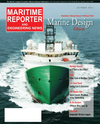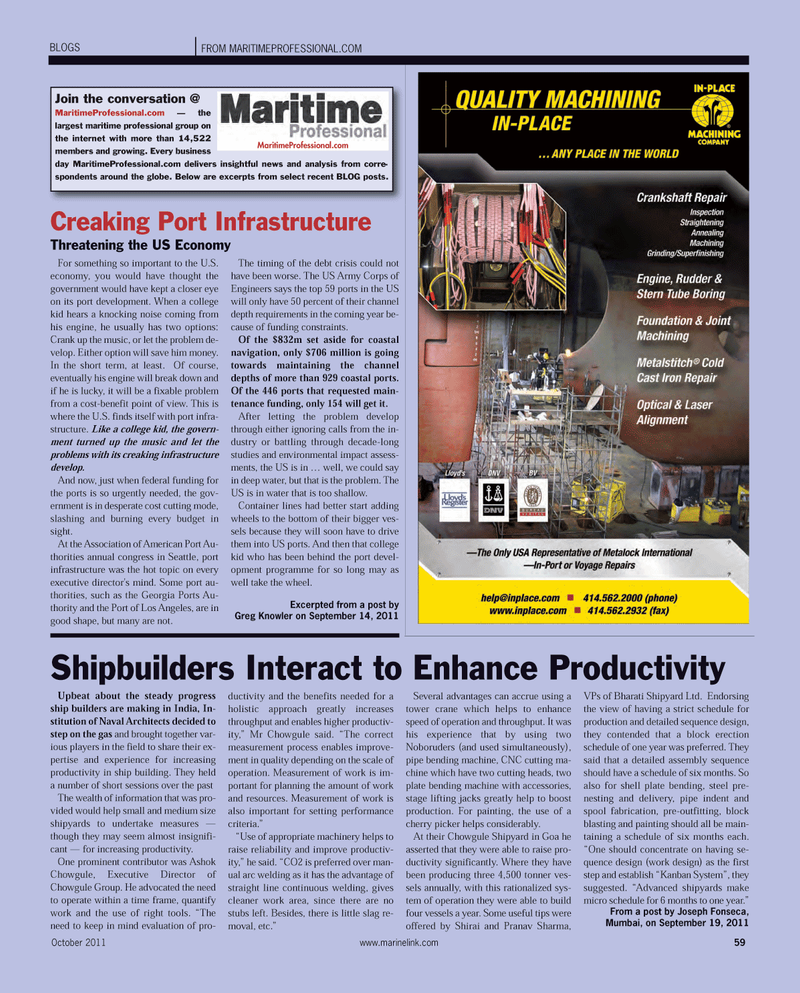
Page 59: of Maritime Reporter Magazine (October 2011)
Marine Design Annual
Read this page in Pdf, Flash or Html5 edition of October 2011 Maritime Reporter Magazine
Upbeat about the steady progress ship builders are making in India, In- stitution of Naval Architects decided to step on the gasand brought together var- ious players in the field to share their ex- pertise and experience for increasing productivity in ship building. They held a number of short sessions over the past The wealth of information that was pro- vided would help small and medium size shipyards to undertake measures ? though they may seem almost insignifi- cant ? for increasing productivity. One prominent contributor was Ashok Chowgule, Executive Director of Chowgule Group. He advocated the need to operate within a time frame, quantifywork and the use of right tools. ?The need to keep in mind evaluation of pro- ductivity and the benefits needed for a holistic approach greatly increasesthroughput and enables higher productiv- ity,? Mr Chowgule said. ?The correct measurement process enables improve- ment in quality depending on the scale ofoperation. Measurement of work is im- portant for planning the amount of work and resources. Measurement of work is also important for setting performancecriteria.? ?Use of appropriate machinery helps toraise reliability and improve productiv- ity,? he said. ?CO2 is preferred over man- ual arc welding as it has the advantage of straight line continuous welding, gives cleaner work area, since there are no stubs left. Besides, there is little slag re-moval, etc.? Several advantages can accrue using a tower crane which helps to enhance speed of operation and throughput. It was his experience that by using two Noboruders (and used simultaneously),pipe bending machine, CNC cutting ma-chine which have two cutting heads, two plate bending machine with accessories,stage lifting jacks greatly help to boostproduction. For painting, the use of a cherry picker helps considerably. At their Chowgule Shipyard in Goa he asserted that they were able to raise pro- ductivity significantly. Where they have been producing three 4,500 tonner ves- sels annually, with this rationalized sys- tem of operation they were able to build four vessels a year. Some useful tips were offered by Shirai and Pranav Sharma, VPs of Bharati Shipyard Ltd. Endorsing the view of having a strict schedule for production and detailed sequence design,they contended that a block erection schedule of one year was preferred. They said that a detailed assembly sequenceshould have a schedule of six months. So also for shell plate bending, steel pre-nesting and delivery, pipe indent and spool fabrication, pre-outfitting, block blasting and painting should all be main-taining a schedule of six months each.?One should concentrate on having se- quence design (work design) as the first step and establish ?Kanban System?, they suggested. ?Advanced shipyards make micro schedule for 6 months to one year.? From a post by Joseph Fonseca, Mumbai, on September 19, 2011 October 2011www.marinelink.com 59BLOGSFROM MARITIMEPROFESSIONAL.COMJoin the conversation @ MaritimeProfessional.com ? thelargest maritime professional group on the internet with more than 14,522 members and growing. Every business day MaritimeProfessional.com delivers insightful news and analysis from corre- spondents around the globe. Below are excerpts from select recent BLOG posts. MaritimeProfessional.comCreaking Port Infrastructure Threatening the US Economy For something so important to the U.S. economy, you would have thought the government would have kept a closer eye on its port development. When a college kid hears a knocking noise coming fromhis engine, he usually has two options: Crank up the music, or let the problem de-velop. Either option will save him money. In the short term, at least. Of course,eventually his engine will break down and if he is lucky, it will be a fixable problem from a cost-benefit point of view. This is where the U.S. finds itself with port infra- structure. Like a college kid, the govern- ment turned up the music and let theproblems with its creaking infrastructuredevelop. And now, just when federal funding for the ports is so urgently needed, the gov- ernment is in desperate cost cutting mode,slashing and burning every budget in sight.At the Association of American Port Au- thorities annual congress in Seattle, portinfrastructure was the hot topic on every executive director's mind. Some port au- thorities, such as the Georgia Ports Au- thority and the Port of Los Angeles, are in good shape, but many are not. The timing of the debt crisis could nothave been worse. The US Army Corps of Engineers says the top 59 ports in the USwill only have 50 percent of their channel depth requirements in the coming year be-cause of funding constraints.Of the $832m set aside for coastal navigation, only $706 million is going towards maintaining the channel depths of more than 929 coastal ports. Of the 446 ports that requested main- tenance funding, only 154 will get it.After letting the problem develop through either ignoring calls from the in-dustry or battling through decade-longstudies and environmental impact assess- ments, the US is in ? well, we could sayin deep water, but that is the problem. The US is in water that is too shallow. Container lines had better start addingwheels to the bottom of their bigger ves- sels because they will soon have to drive them into US ports. And then that college kid who has been behind the port devel- opment programme for so long may aswell take the wheel. Excerpted from a post by Greg Knowler on September 14, 2011 Shipbuilders Interact to Enhance Productivity MR Oct.11 # 8 (57-64):MR Template 10/6/2011 4:03 PM Page 59

 58
58

 60
60
